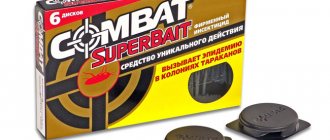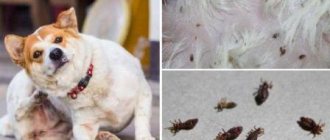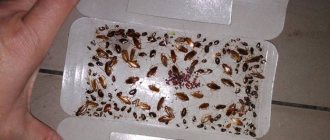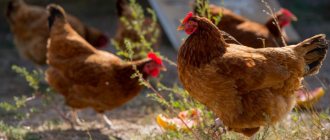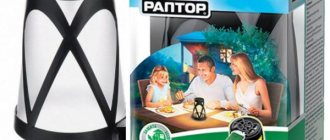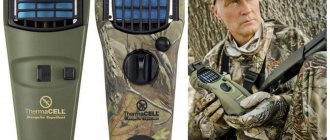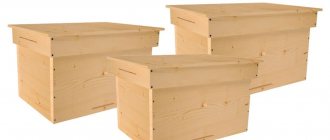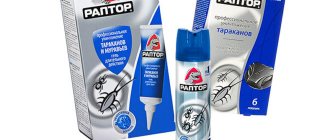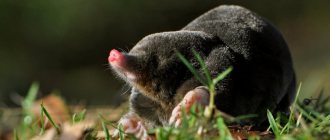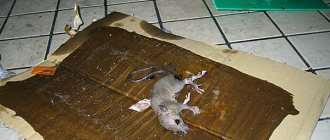video news
The wild boar, also known as the wild pig or boar, is a coveted trophy for hunters not only in Russia, but throughout the world. The value of wild boar is probably explained by the difficulty of its extraction. He is smart, quick-witted and always ready to stand up for himself, even in the mortal danger posed by his sharp fangs. Male boars often rush at hunters, inflicting lacerations on them, and females, whose tusks are less developed, knock them down and trample them into the ground with their front hooves.
Making carp rigs with your own hands
We have already touched on the topic of carp rigs superficially. Now let's look at them in more detail.
Carp installation “Safe clip”
Safety clips are an element that attaches the sinker to the fishing line, facilitating the easy release of the fish from the sinker if the main line breaks.
This equipment has advantages over other equipment when fishing in snags, since the load is secured in a safe clip, which guarantees detachment under strong tension.
We will need:
Instructions:
Carp equipment Inline (Inline)
There are many types of Inline installations described on the Internet, and most of them structurally replicate the Running Feeder Rig. But historically, Inline is a carp rig for carp fishing (waiting) fishing, not feeder fishing. In carp fishing, a feeder tip is not used as a bite alarm, but a bite is detected by an electronic alarm. When the line is released from the reel, the alarm makes a sound. Naturally, this is a sliding equipment, which means it is sporty.
Inline is suitable for fishing on rocky hard bottoms and shell rocks. Unsuitable for fishing in snags, since the sinker does not shoot off under strong tension. It's also bad on muddy bottoms.
Feeder installation Inline is very good at self-hooking carp and carp due to the drop-shaped shape of the sinker. The part of the sinker close to the leader has a thickening, which gives much more resistance to lifting from the bottom. Consequently, the hook with the sinker is sharper.
You will need:
Instructions:
How to make a loop for a hare
In my opinion the effect is the same. At least for me, hinges with locks are new. In my opinion, we don’t have such descriptions in old or new books. The thing is truly deadly.
It seemed to me then that the locals were most outraged not by the pickled grain, but by the Chinese, and without their consent. I don’t argue. I read it with interest.
A short introduction or what the law says
But I still try to plan and minimize this risk. And I won’t pass by those breaking bottles either. Just like you. I don’t know what about the face, but I will definitely make a remark and ask you to remove the fragments. And I even collect shell casings for myself, Lord, there’s no need to distort and generalize.
I don't want to be holier than the Apostle Peter, but there are things I really don't understand. For example, loops in the middle zone, in frequented hunts. Precisely in Russia. Where I live and hunt. Is my position clear? In what ways is it not acceptable? You don’t even need to blame the old editions for the Multi-volume “Encyclopedia of the Hunter”, with a claim to a gift edition, publishing house “Mozhaisk-Terra” LLP, Mozhaisk, etc. Do you read other people’s posts?
Squints are caught for various reasons: some want to master all the methods of hunting, while others are trying to reduce the population of these animals near their gardens. Ancient ancestors invented a loop method of hunting so as not to run through the forests with a weapon after prey. The advantage is saving effort and time, since it is difficult to catch up with this fast creature. In any case, to get acquainted, you need to know how to put loops on a hare and catch the animal correctly. Contents Features of snares Finding trails Opinions of experts Materials and tools Making a hunting device Arrangement of a hunting place Installing a trap Killing device Design of a live trap Disguising traces The dangers of poaching Hunting Features of snares Previously, assembling traps used braided ropes and other improvised materials.
Hunting with decoy
Wild boar can be successfully hunted using the sound of a decoy. The hunter does not seek to lure the animal to himself, but makes a sound similar to the grunt of a boar in order to go out at night to the field where the animal feeds. Many decoys make sounds reminiscent of piglets grunting. The boar, with her maternal instinct awakening, follows the sound and allows herself to be shot.
There are also decoys on sale that imitate the voices of a wounded hare or the cry of a bird. The wild boar even feeds on carrion due to its omnivorous nature and therefore goes towards the sound in surprise. The industry produces a huge amount of decoys, but this method of hunting is still a curiosity among Russian fishermen, although it has already gained great popularity in the West.
Preparing for the hunt
How to put a noose on a boar? First of all, you need to prepare for the hunt. This will take time. It is necessary to study boar trails and the paths along which artiodactyls most often move. Typically, such animal roads pass near ponds, thickets, swamps and tree debris.
Boar trails are found in almost all hunting areas. And even in the most unexpected places. You can find them where wild boars rub against the trunks, rubbing their fur. This is clearly visible from the worn bark of trees growing nearby. Before setting a trap, you need to study the habits of artiodactyls.
How to make a trap?
Hunting without a gun means catching prey using traps and snares. A do-it-yourself trap made from available materials in the forest will help you survive, and during a hunt it will become an additional way to catch game of various sizes. You can learn how to make a trap so that the hunting process is as effective as possible from the video clip, as well as the information below.
Types of traps
Depending on the type of game, the material and method of making the trap are selected. For small-sized game, the base of the trap is made of wire, metal arcs, rings, sticks, branches, and the trap itself is made of fishing line, rope, tendon fibers, etc. To catch large animals, traps made of durable materials are used - iron, parachute lines, nylon ropes, canvas, etc. For hunting fur-bearing animals, there are three groups of self-catchers:
The first group sets up on the animal trail. They come in different types, but they are united by a common design: two connected arches with a base that hold the animal's limbs using springs. Trace traps are divided into frame traps, plateless traps, and those with a plate guard on a direct base. Plate baits are used for catching sable, muskrat, marten, beaver, and fox. A plate trap with a guard is designed for catching martens.
Wood traps are mainly used for catching squirrels. Its design consists of a pointed crutch, which is fixed in a tree, the arc is directed downward, and a canopy is installed above it.
Walk-through traps have other names - humane, pressure. They are characterized by the fact that the animal is killed almost instantly, without much torment or dragging.
They are used for hunting small and medium-sized animals: muskrat, ermine, squirrel, gopher, ferret, mink, marten, sable, etc. Traps of this type capture the animal not by the limbs, but by the head, neck or torso. At the same time, the animal’s valuable fur is not damaged, since the trap is made of wire of various diameters and does not have sharp corners or protrusions. Installation is carried out on ice, swamps, on paths, in holes, in trees, in snow at any time of the year.
Catching wild boars using stationary traps
Catching wild boars for resettlement in order to increase the productivity of hunting grounds has been successfully carried out for many years in our country and abroad (Chichikin, Vorobyov, 1967; Komov, 1972; Andrzejewski, Jezierski, 1978). According to the data summarized in the monograph by M.P. Pavlov (1999), from 1937 to 1992, 7,620 wild boars were settled on the territory of the Russian Federation alone. However, trapping for the purpose of tagging wild boars for scientific purposes was not carried out in the USSR until the 1980s (Kucheruk, Nikitina, 1980). Abroad, on the contrary, in recent decades, mass catching of wild boars has been organized for the purpose of individual tagging with ear tags (Meynhardt, 1982; Stubbe, 1982; Tsarev, 1986) and radio collars (Mauget, 1979; Spitz et al., 1984, Tsarev, 2000) . Wild boars are caught using stationary and portable (box) traps, as well as nylon nets, after which all adult animals are immobilized and marked with various tags. Immobilization of wild boars using pharmacological drugs is carried out by professionally trained specialists and veterinarians. With mass immobilization of ungulates, the waste percentage even among specialists is 10-30% of the immobilized livestock, depending on the quality of the drug. The cost of drugs and equipment for immobilization is very high. Therefore, a new trap design was developed to capture and temporarily hold an entire group of wild boars for the period of tagging. In addition, reliable methods of restraining and tranquilizing caught animals have been tested in order to ensure the safety of catchers, reduce animal stress and injury to wild boars during tagging (Tsarev, 2000).
Design of a stationary trap for catching herds. Based on domestic and foreign developments, an original 10-sided stationary trap was built from pine poles, 2.5 m high, about 9 m in diameter, with two trap doors made of boards (2 m wide and 1.5 m high), located one opposite the other (Fig. 1 A and B).
Fig. 1A. General view of a stationary trap.
Fig.1.B. Scheme of a stationary trap.
The main working part of the trap was the fixing string (Fig. 2.A). It is a cone-shaped corridor made of poles 4-5 m long and 1.2 m high, which is divided into two equal parts by three fall doors (Fig. 2.B).
Fig. 2A String for passive fixation of wild boars, general view.
Rice. 2.B Device diagram.
Movable floor 8. Gate handle lock
2. Lifting rope 9. Intermediate door
3. Center pole 10. Inlet door
4. Guide board 11. Poles
5. Exhaust door 12. Dirt floor
6. Gate 13 Pit for moving floor
7. Gate lock cable
The first part of the corridor is inlet, the second is fixing. The width of the inlet door (board panel) is 0.8 m, the outlet door is 0.5-0.6 m. The outlet door is made of round oak poles with a diameter of 4-5 cm, vertically nailed to guide boards, at intervals of 7-10 cm , metal pipes or firmly fixed chain-link mesh so that the wild boars can see the exit from the corridor. The floor of the fixing part of the string is mounted on poles at a height of 0.6-0.8 m from the bottom of the pit. In the inlet part of the corridor the floor is solid (earth). In the fixing part, instead of the floor in the middle of the corridor, there is only one round pole with a diameter of 12-15 cm. Two boards are nailed to the lower poles of the walls of the fixing part of the string at an angle of 450 to the central log. A gap of 15-20 cm is left between the edges of the boards and the central pole on both sides. From below, under the entire fixing part, a shield made of boards is placed, which serves as a movable floor. The latter is tightly pressed with four cables to the lower poles using an ordinary collar, fixed to poles above the solid plank ceiling of the string. Using the gate, you can easily raise or instantly lower the movable floor by knocking out the lock from under the gate handle (Fig. 2 B). In this case, the boar that has come into line hangs on the central pole, and its legs end up in the air on both sides of it. Having lost support under its feet, the massive animal becomes helpless and can only move its head up and to the sides. This method of passively fixing wild boars allows catchers to quickly and safely mark even large animals with ear and hoof tags or put on a collar with a radio transmitter, without resorting to immobilizing it special expensive pharmacological drugs.
Choosing a place to build a trap. The effectiveness of group trapping of wild boars depends on the following circumstances: the correct choice of place for constructing a trap and its design, the population density of wild boars in the catching area and the ability to attract them to the trap, the climatic and trophic conditions of wintering, the amount and attractiveness of feeding.
In winter, wild boars lead a relatively sedentary lifestyle in small seasonal habitats. This makes it difficult to attract them to the trap. It happened that a herd of wild boars fed for a long time only 300 m from the trap, but did not approach it. Therefore, the trap should be placed as close as possible to the known winter habitats of wild boars, at constant transitions between them or at places of long-term feeding. It is best to build a trap in the center of a forest clearing with an area of no more than 0.3 hectares, which is crossed by an abandoned country road. The latter will greatly facilitate the delivery of fertilizer. In addition, wild boars willingly use forest roads to travel to feeding areas, so it is easy to use them to attract animals to the capture site.
Another necessary condition is a good view around the trap of at least 30 m. It is known that the leading analyzers in wild boars are smell and hearing. However, vision also plays an important role in determining danger. Moving around the feeding area, a group of wild boars creates constant noise. With poor visibility, adult animals are often frightened by the sound of footsteps of animals approaching the trap; every now and then they become wary, avoid the source of noise from the wind and check their safety using their sense of smell. Therefore, in the absence of a good view near the trap, wild boars spend a long time picking up food next to it, but rarely go inside, for a short time and not as a whole group.
Attracting wild boars to the trap. Methods of attracting wild boars to open and convenient places in the forest for observation are based on the development of conditioned food reflexes in animals to feed with odorous baits. As you know, wild boars search for food using their sense of smell. Having stumbled upon fertilizer (grain with haylage) placed on the path, the animals eat it, partly along with the odorous bait. At the same time, they very soon develop a conditioned reflex to the smell of bait. Focusing on its smell, wild boars begin an active search for additional feeding using their sense of smell. Experience shows that at the end of winter, using this method, both in a coniferous forest and in an oak forest, in 3-5 days you can lure wild boars to an observation point or trap from their feeding area at a distance of 1 to 3 km.
In order to reduce the cost of forage, as well as reduce the time and increase the range and probability of attracting wild boars to traps, the method of laying continuous paths (whiskers) from grain fodder, proposed by Yu.N. Chichikin and G.G. Vorobyov (1967), was improved. This method of attraction was designed for wild boars to accidentally discover additional feeding during their movements in search of natural concentrated food.
To attract wild boars to open areas for the purpose of observing their behavior and photographing them, as well as using traps, an active method is used to lure wild boars out of dense thickets, where visual observations of them are almost impossible. To do this, a little feeding (1-2 kg) is laid out on fresh openings and permanent boar paths connecting feeding areas with the animals’ resting places. The grain is sprinkled with a small amount of strong-smelling haylage on top. Then, along the shortest path to a place pre-equipped for observation, fertilizer is laid out on the ski track or next to it in the snow in heaps of up to 1 kg of grain mixed with odorous bait. The first portion of grain is poured on virgin snow 1-2 m from the boar trail, the subsequent ones - 20-50 m from each other, depending on the terrain and the density of forest plantations. In this case, the odorous bait is not only placed for feeding, but also fixed on the branches of nearby trees and bushes at a height of up to 1 m above the snow surface. No more than 1 kg of grain with haylage is re-laid out in places where the fertilizer was eaten the previous day. It is advisable to apply feeding in the morning, avoiding possible encounters with wild boars. Under no circumstances should wild boars be disturbed in their resting areas.
After the wild boars begin to regularly visit the trap and eat the food placed in it, you can begin visual observations of the animals. The purpose of the observations is to determine the daily activity of wild boars and to determine the sex and age composition of the herd. For observations, it is necessary to equip a “hide” at a height of 4-5 m opposite the “string” so that both fallen doors of the trap are visible. A cable from the “alert” is connected to the ambush. In order not to scare away the wild boars and not to shift their activity to the night, after observations it is necessary to descend from the tower at dusk. First, the assistant must push the wild boars away from the trap on a horse or other form of transport. It is not recommended to get off the tower in front of wild boars. When the composition of the group and the time of their exit to the trap are precisely determined, you can begin to catch the animals.
Boars are very “punctual” animals, therefore, in order not to freeze unnecessarily, it is enough to sit in the trap half an hour before the time at which the wild boars went to the trap on the previous day.
Before catching, a team of 2-3 people drives up to the trap on a sleigh, puts fertilizer inside the trap and a little (as an attraction) around it, guards the fall doors and helps the observer get settled on the tower. After this, all the catchers, except the observer, go to the cordon and wait for the prearranged signal by telephone or walkie-talkie.
Troughs with feeding should be located no closer than 2 m from one another. Only this arrangement of feeding allows an entire group of wild boars, consisting of 10-20 animals, to be accommodated within the trap at once. Otherwise, adult boars, especially males, drive the young animals outside the trap. As soon as all the boars of the incoming herd enter the trap, the observer from the tower, using a thin cable, breaks the guard on the entrance fall doors, and both doors are instantly lowered.
Methods for tranquilizing and immobilizing wild boars . The caught animals begin to frantically rush around inside the trap, throw themselves at the walls, trying to jump over them, and hit the poles hard, which can lead to injury to the animals and even their death from stress. Therefore, abroad, before tagging, all adult animals are immobilized in a trap using various pharmacological drugs.
Methods for tranquilizing and immobilizing wild boars are based on feeding pharmacological drugs along with supplementary food (Montgomery, Hawkins, 1967; Done et al., 1975; Pusateri et al., 1982; Tsarev, 1986, 2000) or injections administered to captured animals using flying syringes and other devices (Henry, 1968; Matschke, Henry, 1969; Krasinski, 1971; Henry, Matschke, 1972; Klauber, Ondercheka, 1982; Chizhov, 1984, 1992).
Calming wild boars is carried out by feeding grain (barley) soaked in a 2.5% solution of chlorpromazine. After visually determining the sex and age composition of the group, the total weight and the required amount of tranquilizer are approximately calculated using a calculation of 1-2 mg of chlorpromazine per 1 kg of live weight of the animal. Due to the fact that aminazine potentiates the effect of all hypnotic substances, when the drugs are used in combination, their doses are halved (Mozgov, 1980).
Most of the grain impregnated with chlorpromazine is laid out in heaps around the trap in those places where cautious adult animals usually stand. After eating food containing chlorpromazine, wild boars enter the trap more boldly and do not struggle so hard in it after being caught.
If necessary, complete sedation of caught large wild boars is carried out using intramuscular injection of 1-2 ml of a 2% solution of rompun or its analogues (rometar, xyla) or 3-5 ml of a 2.5% solution of aminazine or a combination of these drugs in half doses. The adverse effects of aminazine and rompun are weakened by an intramuscular injection of 1-2 ml of cordiamine, lobeline, dopram or yohimbine immediately before releasing wild boars.
Immobilization of large wild boars is carried out by intramuscular injection of rompun at the rate of 2-3 mg of the active substance (xylazine) per 1 kg of live weight of the animal. The boars were immobilized in the trap using an Ushakov injector or flying ShL-28 syringes. Immobilizing adult pigs with rompun in March leads to the death of pregnant females, so the use of this and similar drugs in the spring is not recommended.
Fixing wild boars for tagging. Passive fixation of wild boars was carried out due to the design features of the trap (without immobilizing the animals). In order to securely secure the boar during tagging, one of the catchers climbs onto the roof of the string, lifts the inlet door and hides behind it. The other slowly, without sudden movements or noise, goes around the trap from the back side, thereby pushing the boars back to the front door. The door is immediately lowered behind the wild boar, causing it to rush forward to the exit door and stand with its feet on the movable floor. The catcher, standing on the string, knocks out the latch from under the handle of the gate, and the shield (movable floor), under the weight of the animal, instantly falls into the pit, and the boar itself hangs on the central pole in the fixing part of the string. After marking is completed, the movable floor and at the same time the release door of the string are raised with the help of a gate, and the animal jumps out into the wild (Fig. 2.B). When catching wild boars for resettlement, a transport cage is placed next to the exit door.
Literature
Biotelemetry (application of telemetry in the physiology and ecology of animals) // M.: Mir. 1965. 435 p.
Bromley G.F., Kucherenko S.P. Ungulates of the south of the Far East of the USSR // M.: Nauka. 1983. 304 p.
Komov N. Catching wild boars in the Voronezh Nature Reserve // Zh. Hunting and hunting management. 1972. N1. pp. 22-23.
Kucheruk V.V., Nikitina N.A. The main tasks and results of tagging mammals in the USSR // In the book: Results of tagging mammals. M.: Science. 1980. pp. 3-9.
Mozgov I.E. Pharmacology // M.: Kolos. 1979. 416 p.
Pavlov M.P. Acclimatization of hunting animals and birds in the USSR // Kirov. 1999. 666.
Tsarev S.A. Experience of capturing and group tagging of wild boars in the Forest on Vorskla Nature Reserve // In the collection: Comprehensive studies of the biogeocenosis of forest-steppe oak forests. L.: Ed. LSU. 1986a. pp. 131-140.
Tsarev S.A. Experience of catching and tagging wild boars in the Forest on Vorskla reserve // In the collection: The role of large predators and ungulates in the biocenoses of reserves. M.: 1986b. pp. 141-147.
Tsarev S.A. BOAR social and territorial behavior // Game animals of Russia (biology, conservation, resource science, use). Issue 3. “Tsentrokhotkontrol”. 2000. 113 p.
Chizhov M.M. The use of domestic pharmacological agents for immobilizing animals // In the book: Questions of veterinary medicine in hunting. (Collection of scientific works of the Central Scientific Research Laboratory of Glavokhoty of the RSFSR). M.: 1984. P. 64-83.
Chizhov M.M. Immobilization of wild animals // St. Petersburg, Leningrad Zoo. 1992. 176 p.
Chichikin Yu.N., Vorobiev G.G. Wild boar in the south of Kyrgyzstan // Frunze. Kyrgyzstan. 1967. 80 p.
Andrzejwski R. Jezierski W. Management of the wild boar population and its effects on commercial land //Acta teriologica. 1978. V. 23. N 19. pp. 309-339.
Beason Samuel L., Burd Hohn D. Retention and visibility of plastic ear tags on deer //J. Wildlife Manag. 1983. V.47. N.4. pp.1201-123
Done SH, Lees P., Dansie O., Watkins LW Sedation and restreint of fallow deer with Diazepam // Brit. Vet. J. 1975. 131. N.5. pp.545-548.
Henry Vernon. Immobilizing trapped European wild hogs with Cap-Chur-Bard // J. Wildlife Manag. 1968. 32. N.4. pp. 970-971. Paste into text
Henry Vernon, Matchke George. Immobilizing European wild hogs with Sernylan // J. Tenn. Acad. Sci. 1972. 47. N.3. pp. 81-84.
How and with what to lure a wild boar when hunting?
Hello! Now you will learn about two effective methods that allow you to lure a wild boar to the right place for the hunter to shoot. Anyone can do this without any problems. They have been tested in practice, so they give excellent results.
As a rule, in hunting grounds, feeders are made in separate places where wild boars go to feed. Often towers are placed near such places to hunt them.
By nature, wild boars eat a variety of foods, but there are foods that are more attractive to them. It is better to pour it into the feeders in order to attract the animal with a high probability.
It is worth noting that it is not only food that attracts the boar’s attention and makes it come to the same place almost every day. What are we talking about? You will soon know about this
Hunting boar on crossings and in the mud from ambush
Wild pigs love to wander along their favorite trails. They cross rivers and leave traces in the form of prints, droppings and urine. This is where they make the stop. A hideout is a shelter made by a hunter from boards, branches, spruce branches, wire and rope. If the hiding place is made in a tree, it is called a storage shed.
The material used should be wood from trees that grow in the area. There is a small hole in the hiding place through which observation is made and a shot is fired. The hunter must be quiet, not make noise, not smoke, and not drink alcohol.
It is enough to see a wild boar leaving for a watering hole and make an accurate shot, unexpected for the animal. After all, if the ambush is done well, then the boar will never see the person who shot him. But to do this, you should choose a day so that the wind blows towards the person, and not from the hunter towards the animal.
The summer wild boar is annoyed by mosquitoes, gadflies and midges. That's why he loves to take mud baths. He happily swims in puddles and forest lakes, while snorting joyfully and receiving incomparable pleasure from the water procedure. To wash off the dried mud, the animal itches on the bark of trees.
The boar comb and mud bath serve as a guide for the hunter. This is where the shelter is made. They usually hunt at night, when the moon is shining brightly, and the flashlight on the gun serves as a reliable assistant. Hiding should be done not only near boar trails, feeding areas and mud procedures.
You can make a storage shed near an apple orchard, potato field, corn and oats plantings. The wild boar is omnivorous, so it can visit any field sown with crops. At the stand there is an hour or two of waiting patiently and in complete silence for the boar to move. For safe hunting, it is preferable to make a storage shed.
In it, an angry boar will not be able to attack the hunter. In addition, from above it is better to observe the movements of the forest inhabitants. You should wait for the wild boar to start eating, and only then shoot.
You should not shoot at suckling pigs; this is very inhumane and punishable by law. A real hunter will wait for the cleaver to come out and shoot at it, trying to hit a vital organ.
How to catch a wild boar using a trap?
First of all, it is necessary to study the main places where their life activities take place. It makes sense to set a trap where game animals feed. These may be those forests and fields where many fruits grow, which form the main part of the diet of these cautious and can be very aggressive animals. Set a trap by scattering tasty bait in the immediate vicinity of it. Having caught his foot in a trap, the boar has no choice but to remain in place, waiting for the hunter.
In Russia, wild boar hunting is quite common and is divided into several species. One of these types will be boar hunting with snares. This type of hunting is not very popular among hunters. But if a hunter has ingenuity and a great desire, then he can try using loops while hunting a wild boar. They say that catching wild boar using snares is considered poaching, but so far it is not prohibited anywhere to use this method.
Behavior of a boar after a shot
The strength of a boar to a wound can be understood from the following examples: an elk wounded in the stomach walks 200-300 meters, after a well-aimed shot it can even fall on the spot, and a boar with a similar wound can cover several kilometers, and a wounded one in the heart can walk another 100 meters.
The wild boar is especially susceptible to wounds in late autumn, when a wild boar forms under its skin. A sure sign of a wounded boar is a drooping tail. Compared to other ungulates, a wounded boar produces significantly less blood, which is explained by the healing of the wound by adipose tissue. Even with a serious injury, blood does not appear on the trail immediately, but only after two or three jumps. Usually, blood in the form of rare drops appears after 100-150 meters. Therefore, it is imperative to follow the tracks of a shot animal for at least 250 meters, even if the shooter claims that he missed.
If the blood beats in spurts, the heart is broken. The presence of many sprayed droplets of blood indicates injury to the lungs. Sometimes when a charge hits, the boar makes a groaning sound, and the gilts squeal. When a charge hits the upper part of the body, the boar writhes, and when it hits the lower part, it jumps. If an animal tries to rise to its front legs after a fall, the spine is damaged. If after the shot the boar falls and struggles on the ground for several seconds, and then gets up and rushes away, this indicates a tangential wound to the skull.
What should the trap be like?
In addition to those listed, there are many other devices for catching artiodactyls. But in this article we will look at the simplest type - a do-it-yourself trap made from a pipe. It should have a small number of holes, a durable frame (for example, made of polyvinyl chloride) and a chain. All parts of the device can be easily combined in 15 minutes using glue and two track links.
Videos and photos clearly demonstrate the appearance of such a trap: durable, quite long (from 1.5 meters in length), with a thick chain. There should be space for corn, which acts as bait. It is important to choose a high-quality steel pin, which must be securely driven into the ground.
This trap is a feeder for artiodactyls, which can attract the attention of a wild boar for several hours. What will the animal be doing? The boar will smell the treat and will try to get it by pushing the trap from side to side. The device will be limited using a chain and an iron pin. While the forest guest is feasting on the grains that have fallen from the holes, you will be waiting for him in the bushes or on a tree with a gun.
What time to hunt wild boars
Generally, the hunting season opens in autumn and closes in winter. Thus, animals have the opportunity to raise offspring. This is necessary so that hunting does not harm the forest ecosystem.
We recommend reading:
How to choose equipment for a winter hike
- Each type of hunting has its own time of year and day. For example, winter is perfect for hunting from a tower. The towers are set up in advance, the feeding areas are already equipped and the boars are accustomed to coming to them.
- There is a way to hunt using ambush. The animal lies in wait in places where the wild boar is accustomed to coming for food. Naturally, this method can only be used in the fall, when the animal has something to profit from in the fields.
- At night, the boar continues to operate, so you can hunt it at night. You just need to choose dark nights when the moon is overcast. Because the animal does not go to open and well-lit edges.
Preparing a storage shed or tower for hunting
It is known that the boar is a cunning and brave animal with perfect hearing and smell, so it is important not only to lure it, but also to remain unnoticed. To do this, they often organize wild boar hunting from a storage shed, a tower and a blind, which must be erected first. You will also have to prepare special areas with food containers and place them in direct line of sight at an effective shot distance. It will not be superfluous to organize the firing zone in advance - remove unnecessary branches that may impair the view.
Wild boar: description of appearance, habitat, nutrition
The wild boar is an artiodactyl mammal, but not a ruminant, that prefers to live in herds. The lifespan of wild pigs is about 14 years, although some individuals have been known to live up to 20 years or more. An adult reaches more than 1 m at the withers and weighs about 200 kg; the body of the animal is covered with coarse black or brown hair. Wild boars choose forest plantations, various thickets, fields, steppes, and taiga to live.
The wild boar is a large, strong and very dangerous animal. European individuals are the largest, and smaller relatives are found in North Africa, China, India, New Zealand, the USA and some other countries.
Sharp fangs make the boar dangerous for humans, although if you do not touch it, it will not be the first to attack. During the breeding season, it is better not to approach the habitat of wild pigs, since, sensing the slightest threat, they can tear to pieces anyone who approaches their offspring. Despite its potential aggressiveness, wild boar are herbivores. It eats acorns, roots and root vegetables, berries, mushrooms and drinks a lot of water. If there is a lack of plant food, bird eggs, larvae, various carrion and sometimes fish can be used.
Research proves that wild boar is an undomesticated pig. This is not difficult to believe, since these animals are very similar to each other. The wild boar differs from the domestic pig in appearance and behavior. He has a shorter and more muscular body, thick and long legs, and thick fur, which should be called stubble. This is a very hardy, strong and fast animal that, if necessary, can easily catch up and outrun any opponent.
The wild boar is the ancestor of the common domestic pig
Weapons and clothing
A weapon for a wild boar must be reliable, work accurately, without misfires. Both smooth-bore and rifled bullet weapons are used for hunting. Smoothbore - for bullets of at least 32 grams, rifled - for bullets of at least 7.62 mm caliber.
The hunter chooses clothes that are warm, practical, and not new. The fabric should not rustle or creak. On your feet - practical boots. It should be taken into account that during the hunt you will have to walk a lot, probably overcoming small water obstacles and wading through mud. Care should be taken to ensure that the shoes withstand all tests.
Remember! Do not wear new clothes or shoes when hunting. Firstly, the boar will smell your scent from afar, and secondly, new things have a habit of rubbing.
Some experienced hunters advise wearing “moccasins” made from boar skin over the main shoes.
A wild boar caught from the approach is not only a valuable trophy, but also proof of the hunter’s experience, courage and composure.
